《双赢谈判全攻略》课程笔记.docx
- 格式:docx
- 大小:73.53 KB
- 文档页数:28
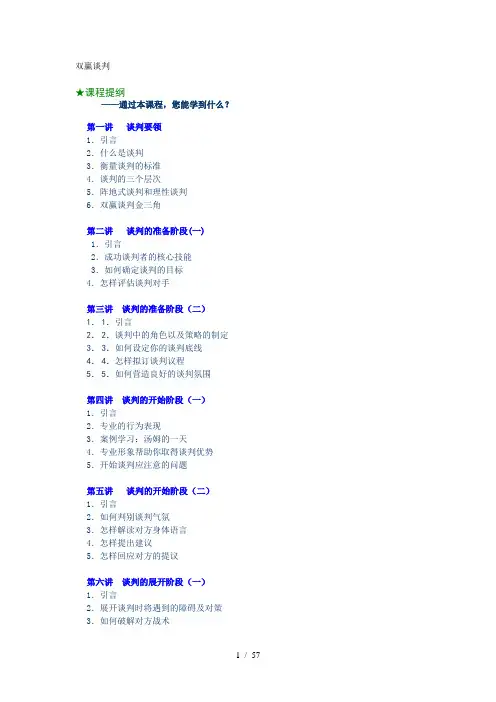
双赢谈判★课程提纲——通过本课程,您能学到什么?第一讲谈判要领1.引言2.什么是谈判3.衡量谈判的标准4.谈判的三个层次5.阵地式谈判和理性谈判6.双赢谈判金三角第二讲谈判的准备阶段(一)1.引言2.成功谈判者的核心技能3.如何确定谈判的目标4.怎样评估谈判对手第三讲谈判的准备阶段(二)1.1.引言2.2.谈判中的角色以及策略的制定3.3.如何设定你的谈判底线4.4.怎样拟订谈判议程5.5.如何营造良好的谈判氛围第四讲谈判的开始阶段(一)1.引言2.专业的行为表现3.案例学习:汤姆的一天4.专业形象帮助你取得谈判优势5.开始谈判应注意的问题第五讲谈判的开始阶段(二)1.引言2.如何判别谈判气氛3.怎样解读对方身体语言4.怎样提出建议5.怎样回应对方的提议第六讲谈判的展开阶段(一)1.引言2.展开谈判时将遇到的障碍及对策3.如何破解对方战术第七讲谈判的展开阶段(二)1.如何面对不同类型的谈判者2.如何建立自身的谈判优势第八讲谈判的评估调整阶段1.1.引言2.2.将面临的困难和解决方法3.3.如何强化自身的优势4.4.如何削弱对方的优势5.5.掌握适度让步策略第九讲谈判的达成协议阶段1.1.引言2.2.达成协议阶段应注意的问题3.3.如何选择结束谈判的方式4.4.如何攻克最后一分钟犹豫第十讲成功谈判技巧(一)1.1.引言2.2.有效地处理对方的拒绝3.3.如何有效地拒绝对方第十一讲成功谈判技巧(二)1.1.引言2.2.探测的技巧3.3.语言的技巧4.4.谈判的技巧5.5.对付不同谈判者的技巧第十二讲如何判别谈判者的风格1.1.引言2.2.谈判的四种风格3.3.优秀谈判人员的特质4.4.课程总结第1讲谈判要领【本讲重点】什么是谈判衡量谈判的三个标准谈判的三个层次阵地式谈判与理性谈判双赢谈判“金三角”什么是谈判谈判,由谈和判两个字组成,谈是指双方或多方之间的沟通和交流,判就是决定一件事情。
只有在双方之间沟通和交流的基础之上,了解对方的需求和内容,才能够做出相应的决定。
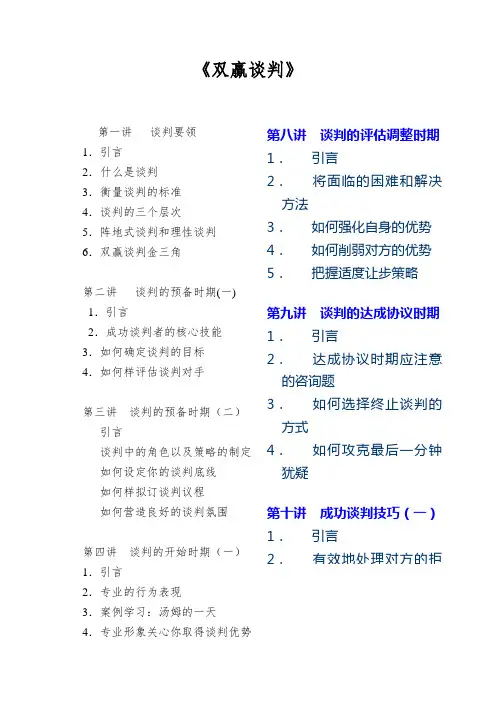
《双赢谈判》1.引言2.什么是谈判3.衡量谈判的标准4.谈判的三个层次5.阵地式谈判和理性谈判6.双赢谈判金三角第二讲谈判的预备时期(一)1.引言2.成功谈判者的核心技能3.如何确定谈判的目标4.如何样评估谈判对手第三讲谈判的预备时期(二)引言谈判中的角色以及策略的制定如何设定你的谈判底线如何样拟订谈判议程如何营造良好的谈判氛围第四讲谈判的开始时期(一)1.引言2.专业的行为表现3.案例学习:汤姆的一天4.专业形象关心你取得谈判优势5.开始谈判应注意的咨询题第五讲谈判的开始时期(二)1.引言2.如何判别谈判气氛3.如何样解读对方躯体语言4.如何样提出建议5.如何样回应对方的提议第六讲谈判的展开时期(一)1.引言2.展开谈判时将遇到的障碍及计策3.如何破解对方战术第七讲谈判的展开时期(二)1.如何面对不同类型的谈判者2.如何建立自身的谈判优势【内容摘要】第1讲谈判要领【本讲重点】什么是谈判衡量谈判的三个标准谈判的三个层次阵地式谈判与理性谈判双赢谈判“金三角”什么是谈判谈判,由谈和判两个字组成,谈是指双方或多方之间的沟通和交流,判确实是决定一件情况。
只有在双方之间沟通和交流的基础之上,了解对方的需求和内容,才能够做出相应的决定。
也确实是讲,谈判是让别人支持我们从对方那儿获得我们想要的东西的一个过程。
如与客户谈判,客户期望你再降价20%,否则,他将从别人那儿采购相应的货品。
这时你是否连续降价,如何与客户谈条件?在谈判中你是否能够自如地操纵整个局面?如果谈判陷入僵局,如何打破,用什么方法打破,你如何处理?在日常生活中,专门多方面都需要谈判,例如学生时代,成绩不行,想想回家如何向家长交代;工作后,如何从领导那儿得到更重要的任务,如何使自己的薪资待遇有更大的提升机会;如何与客户、竞争对手进行沟通;甚至谈恋爱也是一个谈判的过程。
能够讲,小到我们周围的一件小事,大到中国加入WTO,差不多上一个谈判的过程,谈判在生活中无处不在。
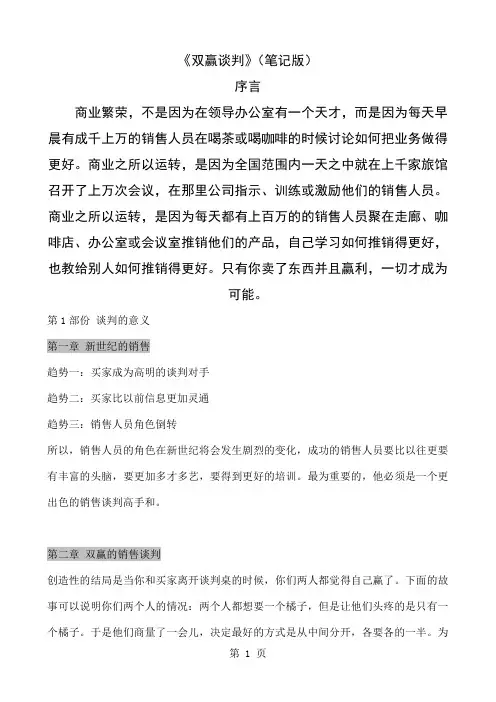
《双赢谈判》(笔记版)序言商业繁荣,不是因为在领导办公室有一个天才,而是因为每天早晨有成千上万的销售人员在喝茶或喝咖啡的时候讨论如何把业务做得更好。
商业之所以运转,是因为全国范围内一天之中就在上千家旅馆召开了上万次会议,在那里公司指示、训练或激励他们的销售人员。
商业之所以运转,是因为每天都有上百万的的销售人员聚在走廊、咖啡店、办公室或会议室推销他们的产品,自己学习如何推销得更好,也教给别人如何推销得更好。
只有你卖了东西并且赢利,一切才成为可能。
第1部份谈判的意义第一章新世纪的销售趋势一:买家成为高明的谈判对手趋势二:买家比以前信息更加灵通趋势三:销售人员角色倒转所以,销售人员的角色在新世纪将会发生剧烈的变化,成功的销售人员要比以往更要有丰富的头脑,要更加多才多艺,要得到更好的培训。
最为重要的,他必须是一个更出色的销售谈判高手和。
第二章双赢的销售谈判创造性的结局是当你和买家离开谈判桌的时候,你们两人都觉得自己赢了。
下面的故事可以说明你们两个人的情况:两个人都想要一个橘子,但是让他们头疼的是只有一个橘子。
于是他们商量了一会儿,决定最好的方式是从中间分开,各要各的一半。
为了保证公平,他们决定一个人切,一个人选。
然而当谈论各自的用途时,他们发现一个需要榨汁,另一个需要橘皮做蛋糕。
他们奇迹般发现他们都能赢,没有人输。
第三章谈判有一套规则谈判和下棋之间最大的区别是:在谈判中,对方不必懂得规则,对方会跟着你的屁股后头跑,从对方多次的表现中,我们知道他会做出怎样的反应。
第2部份谈判开局策略在你同买家接触的初期阶段使用,保证为成功的结局打下良好的基础。
这至关重要,因为,在谈判进程中你会发现,每前进一步都依赖于在开始创造的气氛。
你提出的要求,你表现的态度都必须是你精心策划的一部分,它包含着谈判的所有因素。
建立在对买家、市场、买家的公司进行审慎评估基础上的开局策略决定着你最后是赢还是输。
在谈判开始所做的事情是在为一个双赢的结果做准备。
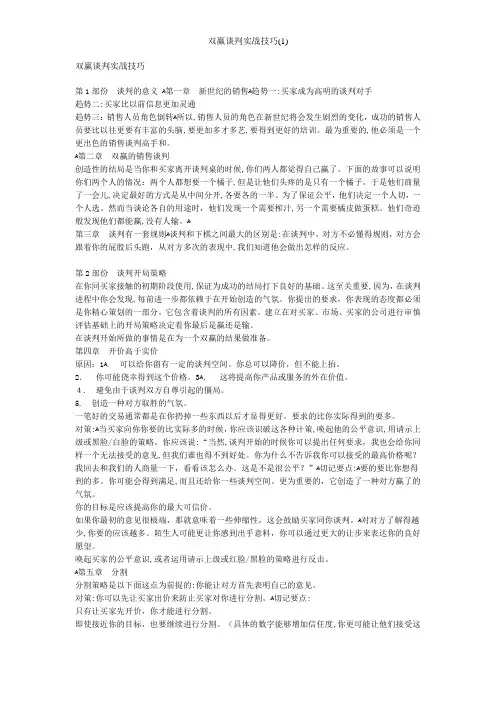
双赢谈判实战技巧第1部份谈判的意义ﻫ第一章新世纪的销售ﻫ趋势一:买家成为高明的谈判对手趋势二:买家比以前信息更加灵通趋势三:销售人员角色倒转ﻫ所以,销售人员的角色在新世纪将会发生剧烈的变化,成功的销售人员要比以往更要有丰富的头脑,要更加多才多艺,要得到更好的培训。
最为重要的,他必须是一个更出色的销售谈判高手和。
ﻫ第二章双赢的销售谈判创造性的结局是当你和买家离开谈判桌的时候,你们两人都觉得自己赢了。
下面的故事可以说明你们两个人的情况:两个人都想要一个橘子,但是让他们头疼的是只有一个橘子。
于是他们商量了一会儿,决定最好的方式是从中间分开,各要各的一半。
为了保证公平,他们决定一个人切,一个人选。
然而当谈论各自的用途时,他们发现一个需要榨汁,另一个需要橘皮做蛋糕。
他们奇迹般发现他们都能赢,没有人输。
ﻫ第三章谈判有一套规则ﻫ谈判和下棋之间最大的区别是:在谈判中,对方不必懂得规则,对方会跟着你的屁股后头跑,从对方多次的表现中,我们知道他会做出怎样的反应。
第2部份谈判开局策略在你同买家接触的初期阶段使用,保证为成功的结局打下良好的基础。
这至关重要,因为,在谈判进程中你会发现,每前进一步都依赖于在开始创造的气氛。
你提出的要求,你表现的态度都必须是你精心策划的一部分,它包含着谈判的所有因素。
建立在对买家、市场、买家的公司进行审慎评估基础上的开局策略决定着你最后是赢还是输。
在谈判开始所做的事情是在为一个双赢的结果做准备。
第四章开价高于实价原因:ﻫ1. 可以给你留有一定的谈判空间。
你总可以降价,但不能上抬。
2.你可能侥幸得到这个价格。
ﻫ3.这将提高你产品或服务的外在价值。
4. 避免由于谈判双方自尊引起的僵局。
5. 创造一种对方取胜的气氛。
一笔好的交易通常都是在你扔掉一些东西以后才显得更好。
要求的比你实际得到的要多。
对策:ﻫ当买家向你你要的比实际多的时候,你应该识破这各种计策,唤起他的公平意识,用请示上级或黑脸/白脸的策略。

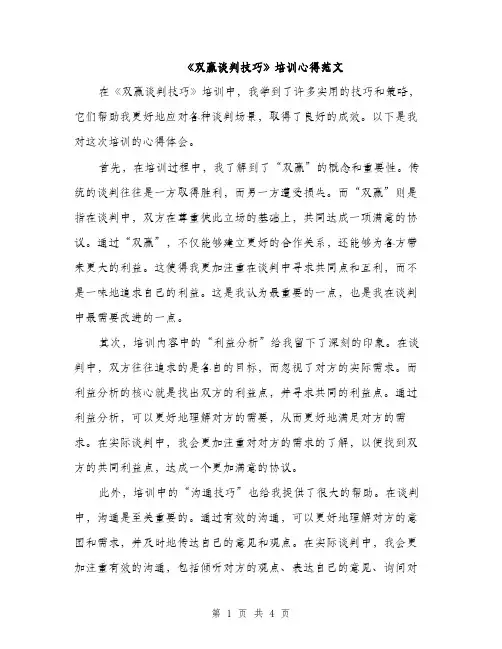
《双赢谈判技巧》培训心得范文在《双赢谈判技巧》培训中,我学到了许多实用的技巧和策略,它们帮助我更好地应对各种谈判场景,取得了良好的成效。
以下是我对这次培训的心得体会。
首先,在培训过程中,我了解到了“双赢”的概念和重要性。
传统的谈判往往是一方取得胜利,而另一方遭受损失。
而“双赢”则是指在谈判中,双方在尊重彼此立场的基础上,共同达成一项满意的协议。
通过“双赢”,不仅能够建立更好的合作关系,还能够为各方带来更大的利益。
这使得我更加注重在谈判中寻求共同点和互利,而不是一味地追求自己的利益。
这是我认为最重要的一点,也是我在谈判中最需要改进的一点。
其次,培训内容中的“利益分析”给我留下了深刻的印象。
在谈判中,双方往往追求的是各自的目标,而忽视了对方的实际需求。
而利益分析的核心就是找出双方的利益点,并寻求共同的利益点。
通过利益分析,可以更好地理解对方的需要,从而更好地满足对方的需求。
在实际谈判中,我会更加注重对对方的需求的了解,以便找到双方的共同利益点,达成一个更加满意的协议。
此外,培训中的“沟通技巧”也给我提供了很大的帮助。
在谈判中,沟通是至关重要的。
通过有效的沟通,可以更好地理解对方的意图和需求,并及时地传达自己的意见和观点。
在实际谈判中,我会更加注重有效的沟通,包括倾听对方的观点、表达自己的意见、询问对方的需求等等。
只有在彼此理解的基础上,才能够达成一个双方都满意的协议。
此外,培训中的角色扮演也帮助我更好地理解和应用所学内容。
通过实际操作,我能够更有针对性地应用所学的技巧和策略,发现其中的不足之处,并加以改进。
通过角色扮演,我认识到在实际谈判中的思维逻辑、表达方式等方面的不足,并逐步改正。
角色扮演还让我更深入地思考谈判中可能出现的各种情况,并找到相应的解决方案。
总结一下,通过这次《双赢谈判技巧》的培训,我学到了谈判中的一些实用技巧和策略,并对双赢谈判的概念有了更深入的理解。
我将在实际谈判中更注重寻求共同点和互利,更加重视对对方需求的了解,并有效利用沟通技巧进行交流。
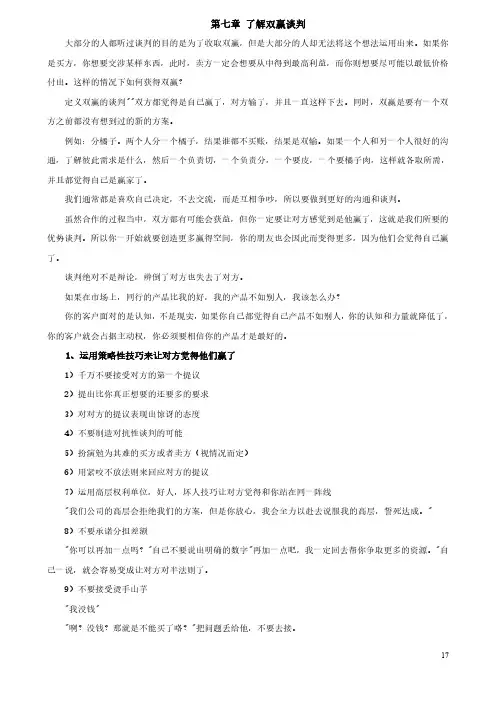
第七章了解双赢谈判大部分的人都听过谈判的目的是为了收取双赢,但是大部分的人却无法将这个想法运用出来。
如果你是买方,你想要交涉某样东西,此时,卖方一定会想要从中得到最高利益,而你则想要尽可能以最低价格付出。
这样的情况下如何获得双赢?定义双赢的谈判""双方都觉得是自己赢了,对方输了,并且一直这样下去。
同时,双赢是要有一个双方之前都没有想到过的新的方案。
例如:分橘子。
两个人分一个橘子,结果谁都不买账,结果是双输。
如果一个人和另一个人很好的沟通,了解彼此需求是什么,然后一个负责切,一个负责分,一个要皮,一个要橘子肉,这样就各取所需,并且都觉得自己是赢家了。
我们通常都是喜欢自己决定,不去交流,而是互相争吵,所以要做到更好的沟通和谈判。
虽然合作的过程当中,双方都有可能会获益,但你一定要让对方感觉到是他赢了,这就是我们所要的优势谈判。
所以你一开始就要创造更多赢得空间,你的朋友也会因此而变得更多,因为他们会觉得自己赢了。
谈判绝对不是辩论,辨倒了对方也失去了对方。
如果在市场上,同行的产品比我的好,我的产品不如别人,我该怎么办?你的客户面对的是认知,不是现实,如果你自己都觉得自己产品不如别人,你的认知和力量就降低了,你的客户就会占据主动权,你必须要相信你的产品才是最好的。
1、运用策略性技巧来让对方觉得他们赢了1)千万不要接受对方的第一个提议2)提出比你真正想要的还要多的要求3)对对方的提议表现出惊讶的态度4)不要制造对抗性谈判的可能5)扮演勉为其难的买方或者卖方(视情况而定)6)用紧咬不放法则来回应对方的提议7)运用高层权利单位,好人,坏人技巧让对方觉得和你站在同一阵线"我们公司的高层会拒绝我们的方案,但是你放心,我会全力以赴去说服我的高层,誓死达成。
"8)不要承诺分担差额"你可以再加一点吗?"自己不要说出明确的数字"再加一点吧,我一定回去帮你争取更多的资源。
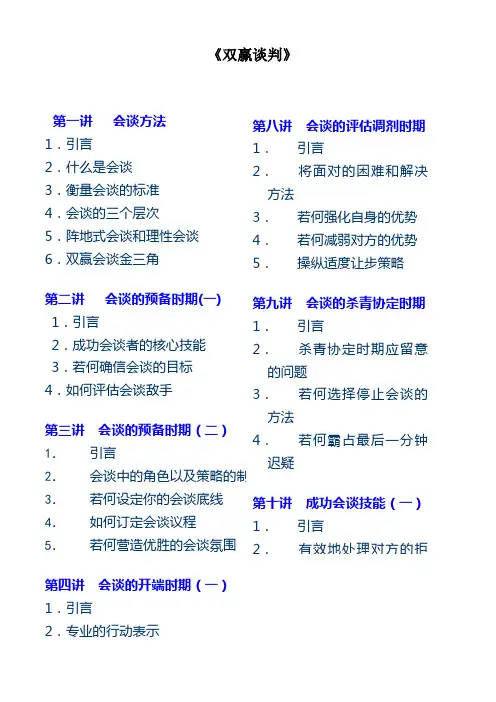
《双赢谈判》1.引言2.什么是会谈3.衡量会谈的标准4.会谈的三个层次5.阵地式会谈和理性会谈6.双赢会谈金三角第二讲会谈的预备时期(一)1.引言2.成功会谈者的核心技能3.若何确信会谈的目标4.如何评估会谈敌手第三讲会谈的预备时期(二)1.引言2.3.若何设定你的会谈底线4.如何订定会谈议程5.若何营造优胜的会谈氛围第四讲会谈的开端时期(一)1.引言2.专业的行动表示3.案例进修:汤姆的一天4.专业形象赞助你取得会谈优势5.开端会谈应留意的问题第五讲会谈的开端时期(二)1.引言2.若何判别会谈氛围3.如何解读对方身材说话4.如何提出建议5.如何回应对方的提议第六讲会谈的展开时期(一)1.引言2.展开会谈时将碰到的障碍及计策3.若何破解对方战术第七讲会谈的展开时期(二)1.若何面对不合类型的会谈者2.若何建立自身的会谈优势【内容摘要】第1讲会谈方法【本讲重点】什么是会谈衡量会谈的三个标准会谈的三个层次阵地式会谈与理性会谈双赢会谈“金三角”什么是会谈会谈,由谈和判两个字构成,谈是指两边或多方之间的沟通和交换,判确实是决定一件工作。
只有在两边之间沟通和交换的差不多之上,明白得对方的需乞降内容,才能够做出响应的决定。
也确实是说,会谈是让别人支撑我们从对方那边获得我们想要的器械的一个过程。
如与客户会谈,客户欲望你再降价20%,不然,他将从别人那儿采购响应的货色。
这时你是否连续降价,若何与客户谈前提?在会谈中你是否能够或许自如地操纵全部局面?假如会谈陷入僵局,若何打破,用什么方法打破,你如何处理?在日常生活中,专门多方面都须要会谈,例如学生时代,成就不行,想想回家如何向家长交卸;工作后,若何从引导那儿获得更重要的义务,若何使本身的薪资待遇有更大年夜的晋升机会;若何与客户、竞争敌手进行沟通;甚至谈爱情也是一个会谈的过程。
能够说,小到我们周围的一件小事,大年夜到中国参加WTO,差不多上一个会谈的过程,会谈在生活中无处不在。

《双赢谈判技巧》培训心得双赢谈判技巧是一种让双方都能获得最大利益的谈判方法论。
我最近参加了一场关于双赢谈判技巧的培训,总结了一些心得体会。
以下是我对这次培训的总结,共4500字。
一、培训内容概述双赢谈判技巧培训主要包括以下几个方面的内容:1. 双赢谈判理念:介绍了双赢谈判的基本原则和理念,即通过合作、协商、互利的方式让双方都能达到最佳结局。
2. 谈判前的准备:讲解了在谈判前的准备工作,包括分析对方需求、了解市场情况、定位自己的底线等。
3. 谈判策略和技巧:介绍了一些常用的谈判策略和技巧,如明确目标、建立亲和力、倾听对方、提出合理建议等。
4. 谈判沟通技巧:重点讲解了有效的沟通方式和技巧,如非语言沟通、主动倾听、积极回应等。
5. 处理谈判中的困难和冲突:通过案例分析和角色扮演等方式,讲解了如何处理谈判过程中的困难和冲突,如拒绝、反驳、妥协等。
6. 谈判后的总结和反思:强调了谈判后的总结和反思的重要性,通过总结和反思可以提高自己的谈判技巧和效果。
二、学习心得体会1. 谈判是一门艺术:通过这次培训,我深刻认识到谈判是一门艺术,需要不断的学习和实践才能掌握。
只有通过不断的学习和实践,才能解决谈判中的困难和冲突,从而达到双赢的目标。
2. 谈判是一种思维方式:谈判不仅仅是一种技巧,更是一种思维方式。
在谈判中,我们要善于发现双方的共同利益和最大利益点,通过合作和协商的方式来实现双赢。
3. 倾听的重要性:在谈判中,倾听是非常重要的一个环节。
只有通过倾听,我们才能了解对方的需求和利益点,从而更好地进行协商和达成共识。
4. 积极的沟通方式:有效的沟通是谈判成功的关键。
在谈判中,通过积极主动地提出合理建议、表达自己的观点和需求,可以增加谈判的成功率。
5. 处理冲突的能力:在谈判过程中,冲突是难免的。
我们需要善于处理冲突,通过合理的方式来解决冲突,达到双赢的目标。
6. 总结和反思的重要性:谈判后的总结和反思是提高谈判技巧的关键。
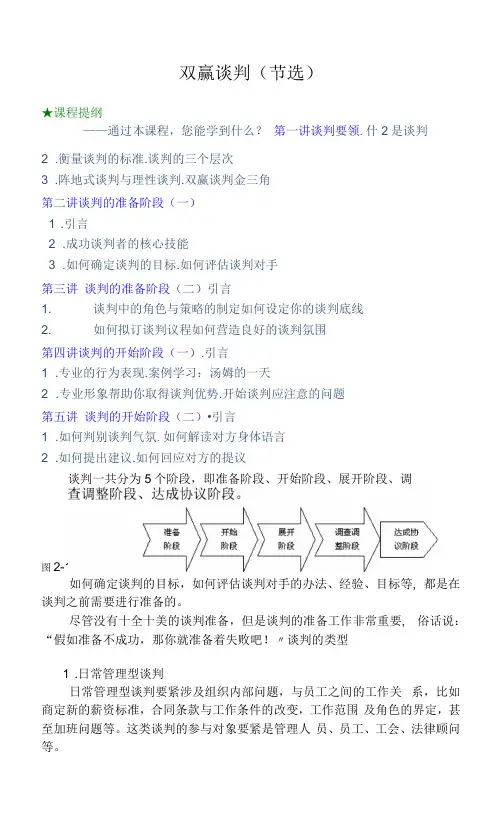
双赢谈判(节选)★课程提纲——通过本课程,您能学到什么?第一讲谈判要领.什2是谈判2 .衡量谈判的标准.谈判的三个层次3 .阵地式谈判与理性谈判.双赢谈判金三角第二讲谈判的准备阶段(一)1 .引言2 .成功谈判者的核心技能3 .如何确定谈判的目标.如何评估谈判对手第三讲谈判的准备阶段(二)引言1. 谈判中的角色与策略的制定如何设定你的谈判底线2. 如何拟订谈判议程如何营造良好的谈判氛围第四讲谈判的开始阶段(一).引言1 .专业的行为表现.案例学习:汤姆的一天2 .专业形象帮助你取得谈判优势.开始谈判应注意的问题第五讲谈判的开始阶段(二)•引言1 .如何判别谈判气氛.如何解读对方身体语言2 .如何提出建议.如何回应对方的提议谈判一共分为5个阶段,即准备阶段、开始阶段、展开阶段、调图2-1谈判的5个阶段如何确定谈判的目标,如何评估谈判对手的办法、经验、目标等, 都是在谈判之前需要进行准备的。
尽管没有十全十美的谈判准备,但是谈判的准备工作非常重要, 俗话说:“假如准备不成功,那你就准备着失败吧!〃谈判的类型1 .日常管理型谈判日常管理型谈判要紧涉及组织内部问题,与员工之间的工作关系,比如商定新的薪资标准,合同条款与工作条件的改变,工作范围及角色的界定,甚至加班问题等。
这类谈判的参与对象要紧是管理人员、员工、工会、法律顾问等。
2 .商业型谈判商业型谈判是公司与公司之间的一个谈判过程。
公司之间的谈判是为了获得盈利,比如为了满足客户的需求而签定一份合同,就交货的时间、服务的范围、产品质量的要求、价格等达成共识。
这类谈判由公司内部的人员、厂商、客户,甚至政府与法律顾问等参与。
3 .法律谈判法律谈判通常比较正式,同时具有法律约束力。
法律谈判要紧就一些问题进行讨论与争辩,比如就某一个地方或者者国家的既定法规,与主管部门进行的沟通等等,都是法律谈判的内容,参与对象包含政府、国家、主管部门与管理人员。
本书所指的双赢谈判,要紧涉及的是商业谈判,即公司与公司之间为了达成本公司的进展目的与盈利目的等,进行商务沟通的过程。
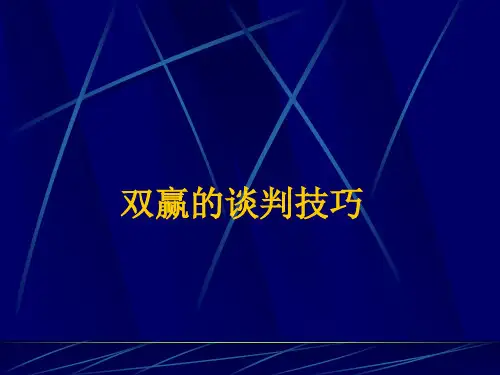
双赢的谈判技巧Document serial number【UU89WT-UU98YT-UU8CB-UUUT-UUT108】双赢的谈判技巧 课程简介 本课程正是从谈判的战略框架着手,深入浅出地向大家阐述了如何才能实现一个双赢谈判的技巧与步骤。
课程收益 参加此次培训,您将:获得谈判能力的自我测试,了解自己的谈判能力如何,并找到可以提高、改善的重点理解谈判战略框架中的7个关键要素是什么并学会如何以此为基础,实现真正的双赢谈判的技巧获得PAC 交流风格测试,了解自我的PAC 特点,并掌握如何发挥自我的优势,促进谈判的目标达成了解双赢谈判的真正含义,掌握如何获得双赢的步骤与方法,迈向卓越的人生颠峰授课对象部门主管、经理、团队的领导者所有追求有效沟通、获得双赢谈判技巧、追求卓越的有识之士课程大纲单元一:双赢谈判概述在这一单元,学员将了解到:自我测试:我的谈判能力如何人们在做谈判准备工作的时候,经常会提出一些疑问,如: “我是应该一开始就提出自己的保价呢,还是等对方先报价呢” “我是应该在他们的地盘上谈判呢,还是应该坚持让他们来我的地盘呢”什么是谈判什么是双赢的谈判卓越的谈判高手应避免的六大错误是什么传统的谈判流程是什么双赢的谈判流程是什么两者的不同在哪里单元二:谈判前的准备工作在这一单元,学员将了解到:谈判之前需要收集哪些信息如何对这些信息进行分析如何根据信息的分析结果制定出有效的计划谈判策略中的7个关键要素是什么谁是谈判中真正的当事人什么是谈判当事人的基本需要和优先考虑的因素我们的最佳替代方案是什么有哪些障碍会阻碍双方达成一致(或阻碍实现双方共同利益的最大化)如何克服这些障碍不同的谈判利益相关者会如何影响谈判的进程和谈判的结果什么事是正确的,是可以做的单元三:成功谈判的技巧在这一单元,学员将了解到:如何在谈判中进行首次报价如何在谈判的过程中进行有效的讨价还价如何探求对方的底线我的PAC交流风格是什么我的优势是什么如何在谈判中发挥我的优势以实现双赢的结果如何与不同PAC风格的人进行有效的谈判单元四:如何达成双赢的结果在这一单元,学员将了解到:什么才是真正意义上的双赢双赢的基础是什么什么才叫做拥有富足的心态如何建立双赢的人际关系制胜的关键是什么双赢协议的含义是什么如何制定双赢的制度与双赢的流程授课方式本课程将采用案例讨论、角色扮演、测试等常用的培训方式,结合讲师的教练式引导,启发学员结合的实际情况进行主动思考,以最大程度帮助学员掌握相应的技能。
《双赢谈判全攻略》课程笔记"Win-win negotiation Raiders" course notesRecommended reasons: too much training, the course of the day seems a little nervous, I feel a little in digestion, the most impressive is the following words・1,PMP successful people, all the way along ..........2,concessions can, unless the exchange, negotiations must not commit suicide, and somehow kill him;3,who speaks first who died;4,can not answer, kick the ball;5,try to let the other party to open conditions, if the price must be open; give yourself leeway, finally small concessionsreluctantly makes it cool.6,pliers + Red white・7,the negotiations are very asymmetric information, as far as possible to obtain more information on each other, must not talk incessantly, to learn to ask questions, business matters -------- what can I do to help you? It's all the way.・・1, bargaining power1)negotiating momentumProfit 二profit (real gain) + name (Xu Rongxin)二win (take advantage of)Meet vanity: smile, PMP (successful people: experience along the way; failure: future plans)Ming Pat: private, sensitive people; dark shot: open, rational people.The ID is emotional, the ego is rational; the person has to be socially, that is, reason, work, and sensibility, which is called superego.2)types of negotiationsCompetitive negotiations: zero sum negotiations, confrontational negotiations;Win-win negotiation: cooperative negotiation;3)negotiating thinkingHow about two cents for an apple?1,I cut you pick: surface win-win, suitable for use in a strong, not strong when;2,each one takes what he needs: the essenee of win-win;3: the strategy of win-win and reciprocity・ Zhejiang.A man who knows only his own interests is called a warlord, and he can not be a monarch・Concessions are made unless they are exchanged・Don,t kill yourself in the negotiation, and kill him anyway.2, preliminary preparation1)basic preparation:Time: never mind. The key is to be well prepared;Location: try to win the home, not to play at home, or in the middle of the game;Person: the other side asks whether you speak or not The best answer: within the purview of count, permissions, go back to askfor instructions・The other party is a party to come, do not count, as far as possible to obtain the other side information, the other party into their own, for their own affairs・ Only principles, not specific issues・2)SWOT analysisStrengths and weaknesses 一bosom friendsOpportunities and threats ——itselfZhiyizhibi, baizhanbudai!3)determine the negotiating objectivesTo offertarget94)draw up alternative strategiesSimulation of various scenes: what their own cards, the other side will be what card, how to deal with their own?.3 、negotiation and communication1)opening techniquesAt the outset, make clear our position;Should be principles, rather than specific; who first talk about principles, who is active, who first talk about specific, who is passive・Wait until the partner has finished and then contradict them・I exist because I am worth you.2)questioning skillsClosed questions: for confirmation, guidanceOpen questions: get down to business・ May I help you? What's your experience?Selective question: when you want to be strong, don,t dare to be strong, for example, about your customers meet, give leadership two programs finalized・The first three questions: what are the successful people (alongthe way you have experience), what you are going to do for the failure, and what is the plan for the general?3)answering skillsAnswer: don,t answer correctly, don,t answer thoroughly, lower your interest, and aim at the other person,s psychology;Don,t answer: get plenty of thought;No answer: kick the ball, make excuses, delay.4)listening ArtOne of the obstacles?: selfish, do not listen to others: (holding a pen with their own - self-willed)Two of the obstacles: less listening, no listeningThree of the obstacles: don,t understand5)the art of speakingGlorious future: words related to fame and fortune;Horror story: but what if the other party graduates from Xiamen University? And what if the other person is scared to death?6)barriers to negotiation and communicationThere is no regulation of their emotions and attitudes;Negative, hostile, or hostile towards the other side;Stick to yourself and ignore the needs of the other side;For face reasons, resistance to concessions:4, negotiation strategy1)prophase strategy (pre layout)Asking price strategyWho will open the condition first? Try to let the other party to open conditions, unless the heart bottom;Open higher or lower? Open high, can leave leeway, let each other very cool;The less you know, the higher the asking price;The more prepared and experienced, the higher the offer;How much higher if you open higher? Never mind the end, open top and credible price; heart bottom, the segmentation strategy for. Such as last year to 9000, and this year would like to rise to 10000, the asking price will be opened 11000.Never kill yourself, and kill him anyway.The horse strategy?Question: when communicating with customers, the biggest confusion is that when the conflicts between the interests of the customer and our interests lead to failure to continue, what can we do?Business: 1. explanation; 2. decomposition, the purpose of killing the other party,s morale・Insider: 1.PMP (along the way); 2. free lunchIt doesn,t work, telling horror stories, exerting pressure, or depicting glorious prospects・Counter-offer strategyKnow how to use segmentation strategy, the heart does not use the vise strategy.Tiger clamp methodSilenee is golden, who speaks first who died;One minute to earn millions, a yuan of money worth more; to hold on to the ball to each other;The reverse strategy: use the vise, it is not the pressure with the red face strategy.Good cop bad cop?If the other party does not accept, then dig vise, it is not red. What a surprise!Negotiation is the process of acting;Two people lose their temper,partner;A man and his good cop, then asaid...)Segmentation strategyQuotations: 90We expect: 80I put it below: 70Try to ask each other for theNever accept a client's firstanother one smooth hair, gold virtual white face ・(my mother first time; offer;Reverse strategy: expose him・ReluctanceNever willing to be in the other party's condition;The scale of the negotiations was compressed from the start;The more willing, the more passive;The reverse strategy: to dig the vise, it is not red・Concentrate!Keep off the negotiations. Real feelings・ Negotiation is a show;What's really important: where are you talking now? What should I do next?2)medium-term strategy (medium term advantage)Ask the leadersThe right to suppress you has no right to put pressure on the other side;Frustrated by the fact that you can,t meet the decision maker;And forced him to stand with me;Dissent strategy90% of the objections are vague and clear;Deal with your feelings first, then deal with them;Process: recognition, admiration, diversion (PMP, free lunch, glorious prospect, or horror story);The reverse strategy: pliers, red and white;Service devaluation 二laterSoon after work, the service drops quickly;So, before you do something, you need to talk about the terms first;After a good talk, hold on, he'11 promise you;Compromise strategyUnfair compromise;Encourage the other side to compromise;When he compromises, we use the vise tactics;Keep it up and the other side will compromise again;Hot potato!What do you think of this thorny problem?I do not, you are supposed to see?You have more experience than me. What can you do about it? Reciprocity?A concession is possible, but at a cost:This will protect your honesty;A reward may really pay off;Asking for a reward increases the value of the concession;Block an endless process;3)post strategy (win loyalty)Good cop bad cop?Nibbling strategyThere is no need to ask for everything!After reaching an agreement, see if there are any other agreementsThe effect: icing on the deal, allowing the other person to agree to something he has previously disagreed with・Concession strategyA concession:1)symbolic concessions;2)conditional concessions;3)ask the leader to give in;Average concessionFinally, make a big strideAll at onceFirst of all, make a small concession to test the depth・Recall strategyThe other side never stops making small concessions;Don,t waste time on important matters, because it really irritates each other!You can go back on a compromise, or go back on fees, in eluding additional terms such as training・Petty?Finally, a small step will make him feel that he has won, so don't give up all at first;The key is the timing of the concession, not the size of the concession. It can be very small;Using these tactics, a negotiator can make someone feel better. Draw up a contractThe party to whom the contract is written has an advantage;Only when we write it can we know whether we are talking about a good deal or not;Once the oral agreement is written down, the meaning will vary; Remind you to include all the terms you want;Notes encourage you to write down what you were not willing to accept;5, control negotiationsCharacter control, learn to split personality, bullshit, talk to people.One thing is worth another・ Touch control type of people (fast rhythm), deal with him with analytical character; meet analytical person (good slow), deal with him in plain type character; plain type people encounter (slow fast), deal with him with expressive character, met expressive people (fast rhythm he used to control), deal with the type of character・In the troubled times, legalist thought was used to spread Confucius thought, and the legalist thought was in his mind・2. 1 game theory and negotiationFrom the 20 world in 70s, the application of game theory in the economic field, the study of many economic phenomena and economic behavior can be understood as a game problem, can be analyzed by game theory. In recent years, as game theory has been applied more and more widely, game theory has attracted more and more people's attention in the negotiation activities, which has aroused people,s interest. The negotiation behavior of complicated and uncertain through game analysis of clear and concise make the research more scientific, standardized and systematic, find out someregularities, establish a analysis model, so as to construct the basic framework of negotiation theory analysis・2. 1. 1 negotiation by game theoryThe,z game theory" from English Game Theory, the basic meaning ofthe word ,,Game,/ is the English game・There are many forms of game・ Here we analyze the classical game problem and establish the basic model of negotiation and cooperation.Negotiation modelWang Eryou an old car, assuming he owns and uses it for 3000 yuan; Lee five year-end 5000 yuan bonus, he decided to buy two of the king's old car, he thought the car worth 4000 yuan.Let's say the transaction price is 3500 yuan・Prisoner,s dilemma is a non cooperative game situation. Suppose two suspects were tried in separate rooms, unable to communicate and aerate each other・ The police showed two suspects that if a man confessed and his accomplices were out of commission, the confession would be held for half a year, and his accomplices would be held up for 10 years, and if they did, they would be sentencedto 5 years, imprisonment・ If they do not confess, they will be sentenced to one year each sentence. We know that the best strategy and choice for the two suspects in this game is that neither side pleads guilty・ But six months in prison is the most attractive, so each suspect may have the motivation to admit that both parties may plead guilty, resulting in imprisonment for five years・ See Figure 2TNow let us assume the use of game theory here, that is the result that a "'cooperative solution" and a "non cooperative solutio The so-called ''cooperative solution'' means that Wang two and Li Wu agreed on the transaction price, thus enabling the successful completion of the old car transaction.Non cooperative solution is refers to the two person bargaining, Each sticks to his own stand・ in price, failed to reach an agreement・ If two people failed to cooperate, Wang two still retains his old car, its benefit is 3000 yuan, Li five still hashis 5000 yuan, Wang two risk value of 3000 yuan, Li Wu 4000 yuan, so no solution for the 3000+4000=7000 yuan of gross cooperation. From the cooperative solution, if Wang two sold the car to Li five, he said to Li Wulai, "this car is worth 4000 yuan. Besides, thereis a shared benefit between the two sides. 〃・If 3500 is thetransaction price, Wang Erzuan got 500 yuan, Li five savings of 500 yuan, gross cooperation solution is 4000+500+3000+500=8000 yuan, obviously, this is not cooperation to increase the value of 1000 yuan・2.1.2 negotiation procedures on the basis of gameThrough the above analysis, we can divide the negotiation process into three steps: one is to establish the value of risk; two is to establish the surplus of cooperation; three is to reach agreementto share the surplus・1,establish risk valueThe establishment of value at risk refers to the evaluation of the contents of the transaction to be conducted by the parties to be planned・2,establish cooperation surplusWhen the value of the risk is determined, it will form the surplus of cooperation between the two sides, that is, the 1000 yuan we mentioned above, but how to allocate here is the most critical issue・The basic problem of determining the surplus of cooperation is how to distribute the interests of all parties participating in the game・ In many cases, the increase in the interest of one party must be the decrease of the other party,s income, but no matter how it is allocated, it does not affect the total result change, which is called zero sum game・Modern negotiation concept: negotiation is not a piece of cake after, discuss how to divide, but want to make the cake bigger, so that each party can be more points・ This has been proved by game theory, that is, game of change and game・ The study of variable sum game is to combine different strategies so as to increase the profits of all parties in the game・ This means that participation in the negotiations (Bo Yi) between the parties there is mutual cooperation, that is, under their own interests, driven by a conscious and independent attitude and behavior of cooperation.3, to reach agreement to share the remainingOn the above, the remaining is refers to between two to 3000 yuan car evaluation of Wang and Li five to 4000 car far evaluation of the difference between 1000 yuan, whether this should be how to allocate the remaining average or not, on average, depends on many uncertain factors・ In fact, many negotiations are difficult to determine even if there is a surplus of cooperation between the two parties・ As far as equity theory is concerned, there are many ways of allocating, and if they are able to recognize that an agreement is beneficial to both of them, the understanding and cooperation between the two sides is entirely possible・An agreement is a guarantee for the parties concerned to share the remaining cooperation, and also a link to maintain cooperation among all parties・2. 2 fairness theory and negotiation(1) the basic connotation of the theory of equityThe fairness theory proposed by Adams, an American behavioral scientist in 60s, is the most representative and has a profound influence on people,s social practice・ Adams is based on the basic elements of people,s perception of fairness,Established the functional relationship among these elements, and summed up the formula to measure people,s sense of distributive justice0p/Ip=0r/IrIn formula, 0 refers to the outcome, that is, what is allocated, including material, spiritual, or whatever the party considers worthy of consideration;means devotion, that is, the contribution that people contribute, and also the mental, physical, and related elements;P stands for those who feel just or unjust;R stands for the reference object in comparison, which can be the average state of a specific person or group, or the state that the person has experienced or envisioned in the future・(two) the elimination of the sense of injusticeWhen people feel unfair when eating, they feel resentful or resentful, and then affect the whole mood and behavior・ The consequences are extremely negative・ In order to restore the sense of fairness, we need to eliminate the root causes of unfairness:First, actually expand your income from Op, or increase the contribution of the other Ir, and reduce yourself to pay Ip or reduce the other party,s income Or.But in fact, in addition to I, the other three situations are outof control, so the main way to restore justice is to reduce the amount of I that you offer・Second, change the reference object to avoid unfairness.Changing the opposition can quickly dispel people,s sense of injustice・ There is an old saying, called "less than, more than surplus"', refers to change the reference object, people,s psychological state・Third, quit comparing to restore balance.The way people adjust their sense of unfairness, mentality, and one of the more common things is to get out of the balance・ In real life, people do not have a sense of fairness is formed in the comparison of reference of the next, so the easiest way toeliminate the unfairness, exit is compared, when CF matter disappears, bumpy also disappeared・(three) the criterion of "fairness";We explore the basic meaning of justice, and the way people try to eliminate the sense of injustice・ Then, is there a general criterion for the distribution of justice? In other words, what is the basis for fair allocation?1,the theory of fair distribution of the four optionsIn western culture, people mainly consider two aspects of the study of justice・ First, what factors should be put into the ,,fair/,operation, and what kind of allocation should be adopted in two?・The negotiation in the "justice" to discuss the issues and evaluation standard, an example with experts on game theory isoften discussed, is the two negotiations between the parties, the rich and the poor to z,fair,z share of $200.Program 1: to psychological tolerance as a standard, according to the proportion of 150:50 distribution, the rich get more copies・Because psychologically, 50 dollars is a big amount for the poor・The poor lost $50, equivalent to 150 dollars for the rich. There is some truth in the standard of psychological acceptance・ For example, some social organizations have reliefactivities,Donations are often made according to people,s income・Programme two: the principle of compensation in actual need・According to the above proportion, but let the poor take one more, it is reasonable for the actual needs of both sides・ That is, the principle of compensation for the weak・Scenario three: the average allocation is proportional to the standard, that is, 100:100, the poor and the rich get half of $200 each・ This distribution looks fairly fair, but since the rich have higher tax rates than the poor, the rich get the $100 and pay less taxes than the poor, so some blame the unfair distribution. But inreality, because this method is simple and convenient, it is the most common method of distribution, and it is also the basis of other evolutionary distribution. Relief funds such as children,s inheritance, enterprise or society.Scheme four: the actual income equality as the standard, according to the ratio of 142:58, the taxable $84 after $142, finally the actual income of $58, $58 in tax and the poor is not equa 1. This distribution is often used to give enterprises the wages of workers is 1ow, but the higher up approach to achieve benefits・2,fair or equitable allocation of the twoThe fair or equitable method of allocation also influences the implementation of the theory of equity. Here we introduce two representative methods, namely, the simple method and theauction method.(1) a simple method proposed by negotiation experts at the Harvard University, they through the research on the issue of inheritance, the inheritance of inheritance expectations, obtained a "fair" allocation of heritage・If a couple dies unexpectedly without leaving a will, how will their three children, Jordan, Michael and Marie, distribute the ABCD four equally and equally?First, let each child evaluate each item, and the results are listed in the tableThe first kind of "justice" allocation is to distribute the goodsto the person who gives the highest price to it, and then the total value of all the articles is equal to the amount shared by thethree children・ This is the basic connotation of the naive law・According to this method, Jordan with the highest valuation of item A in three children ($10000) by A, similarly, Michael D at a price of $2000, Marie respectively to 4000 and $2000 for B and C, the highest valuation ABCD add four items, total amount share for $18000, each child can share one of the 1/3, that is $6000. Subtract their assessment of the items accordingly. As Jordan of A assessment of $10000, $6000 after deducting his share, he should also pay $4000, minus Michael in his assessment of the items D $2000, he should also get $4000, similarly, items B and C valuation equal share of the $6000 Marie, and she was so Jordan 4000 dollars to pay Michae1. Thus the fairdistribution of simplicity was ended.The second method of distribution is called auction. Which is similar to the public auction process all the relics of ascending,The distributor then shared the proceeds of the auction.According to the auction principle, Jordan is still getting the goods A, Michael gets D, and Mar i e gets B and C・ These re la tions have not changed compared to the naive law, but the amount of money they spend is different・ For Jordan, he could get A without having to pay $10000 a little more than a little more than $7000, because he was the only one who bought it when the auction came to $7005・ Similarly, Michael for goods D also only pay 1005 yuan,Marie, respectively, B and C pay 2005 yuan and 1505 yuan. In this way, the total amount of the total auction was 11520 yuan, and the share of the three was equal to 3840 yuan. The specific balance of payments for their Jordan to A specific items to pay 7005 yuan, minus 3840 yuan it, Jordan will have to pay 3165 yuan, and so on, Michael will be 2835 yuan, Marie can get 330 yuan subsidy. From the above analysis we can see that the same can be called "justice", in the specific allocation methods will produce "justice" different results・ A simple method is beneficial to Michael, so he can get a $4000 subsidy in articles D at the same time; and the auction rules favorable to Jordan, he can also obtain goods A, but less than the naive method to pay $835, Marie also love the auction method, because she can get on the two items・ Can also get some subsidies ・It should be pointed out that the auction law we dnalyzed above is based on the assumption that some conditions remain unchanged, mainly for the convenience of the analysis・ In actual auctions, the situation is far more complicated・ Such as to prevent the bid is too low or the bidder collusion, bid price setting; in order to prevent the bidders because there is no cost of bidding for the transaction is not active, causing losses to the seller, bidder must bid request delivery costs, to ensure the implementation of the auction method is the most effective・Has an important guiding significance, problems of basic connotation of justice theory for us to understand and handle the negotiation activity first, because people choose the angle different from the standard, people for the just distribution mode and take the view there will be great differences in absolute justice does not exist・ People sit down and negotiate to reachconsensus and approval on the standard of fair distribution of interests in cooperation. Second, the sense of justice is an important psychological phenomenon dominates people's behavior, if people have a sense of injustice, will greatly affect the actionsof people,s enthusiasm, and people will do everything possible to find ways to eliminate the sense of injustice, in order to psychological balance. Third, no matter what kind of fairallocation method, the psychological factors are more and more important. Because in many cases, people* s views on justice depend on psychological factors・3."black box" theoryIn the middle of the twentieth Century, a new science, cybernetics, was created by American scientist Norbert Weiner. Control is the use of certain means to limit the activity of a controlled objectto a certain extent or to operate in a certain pattern. Cybernetics plays an important role in modern social life, and it has been applied in many fields and has made great achievements・ Applying cybernetics to the field of negotiation,Negotiators will be more procedural negotiation activities, the use of the best model to produce the best results, to achieve the ideal state・In cybernetics, the unknown region or system is usually a "black box", and the omniscient system and region become "white box", between the black box and the white box, or the black box can be regarded as a ,z gray box"〃・Generally speaking, there are widespread "black box" problems which can not be observed but can be controlled in social life・ For example, when we don,t know which key is the key to the door lock, we usually insert the key into the keyhole to see whichone can open the door without having to remove the door lock and look at its internal structure・In reality, there are many things we think we are not "black boxes", but actually they are "black boxes"〃・In response, cybernetics experts gave us an example of a bicycle: 〃we might have assumed at first that bicycles weren't a black box, because we could see every part of it. 〃・As a matter of fact, we just think we know. The first link between the pedal and the wheel was the atomic forces that brought together the metal atoms, which we did not see at all.Four, information theory and negotiation1,the three elements of information modelThe founder of information theory, American scientist Shen Nong, published the mathematical theory of communication in 1948, and proposed a model of information transfer・ The author thinks that the information communication process has three main elements: source, channel and destination. See Figure 2-32,the subjective and objective relationsBy American psychologist Fritsch Hyde, owner and customer relationship information research, pointed out: from the host and guest relations to analyze the transmission of information and the effect will occur in four situations: one is that if the owner and guests have a trusting relationship, and the passenger side passed on the main side of the information is also in favor of theposition of high reputation, high approval, information transfer is best, visitors will also make a positive response; the two is the guests have a crush on the main square, but a negative attitude to。